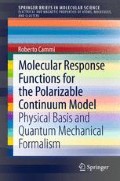Abstract
This chapter considers the properties of the molecular solute in electronic excited states determined from the linear response functions described in the previous Chap. 3. Transition energies and transition moments are determined from a generalized eigenvalue equations, and the first-order properties in electronic excited states are expressed as analytical gradients of the corresponding transition energies with respect to suitable perturbations.
Access this chapter
Tax calculation will be finalised at checkout
Purchases are for personal use only
Notes
- 1.
Here we consider the linear response function for the electronic ground state of the molecular solute.
- 2.
The amplitudes of de-excitation operator \({\fancyscript{M}}=\sum _K\mu _K\tau ^{\dagger } _K\) are determined by the perturbation independent equation
$$\begin{aligned}&<HF|(1+\varLambda )[[e^{-T}H_N e^{T},\tau _K], R_f]|HF >\\&+ < HF|(1+\varLambda )|e^{-T}[Q_N^{|\omega |},\tau _K]e^T|HF > \cdot < HF|(1+\varLambda )|e^{-T}[V_N, R_f]e^T|HF >\\&+<HF|M[e^{-T}H_N e^{T},\tau _K]|HF> \\&+ <HF|M e^{-T}Q_N^{|\omega |}e^T|HF>\cdot <HF|(1+\varLambda )|e^{-T}[V_N,\tau _K]e^T|HF>+\omega \, \mu _K = 0 \end{aligned}$$ - 3.
The coefficients of the \({\fancyscript{Z}}_f\) and \({\fancyscript{T}}_f\) operators are determined from the following set of equations:
$$\begin{aligned} 0 =&< HF|L_f\left[ [e^{-T}H_N e^T,\tau _p], R_f\right] |HF>\\&+< HF|(1+\varLambda ) [e^{-T}\mathbf{Q}_Ne^T,\tau _p]|HF >\cdot < HF|L_f[e^{-T}\mathbf{V}_N e^T, R_f ]|HF >\\&+ < HF|L_f [e^{-T}\mathbf{Q}_N^{|\omega |} e^T,\tau _p]|HF >\cdot < HF|(1+\varLambda )e^{-T}[[\mathbf{V}_N,\tau _p], R_f]e^T|HF >\\&+ < HF|{\fancyscript{Z}}_f [e^{-T}{H}_{N}e^T,\tau _p]|HF >\\&+ < HF|(1+\varLambda )e^{-T}[[{H}_{N},\tau _p],{\fancyscript{T}}_f]e^T|HF > \end{aligned}$$and
$$\begin{aligned} 0 =&< HF|L_f\left[ e^{-T} < HF|\tau _q^{\dagger } e^{-T}\mathbf{Q}_N e^T|HF >\cdot \mathbf{V}_N e^T, R_f\right] |HF >\\&+ < HF|L_f e^{-T}\mathbf{Q}_N^{|\omega |} e^T|HF >\cdot < HF|\tau _q^{\dagger } e^{-T}[\mathbf{V}_N, R_f]e^T|HF >\\&+ < HF|{\fancyscript{Z}}_f e^{-T} > HF|\tau _q^{\dagger } e^{-T}\mathbf{Q}_N e^T|HF >\cdot \mathbf{V }_Ne^T|HF >\\&+ < HF|\tau _q^{\dagger } e^{-T}[{H}_{N},{\fancyscript{T}}_f]e^T|HF >\\&+ < HF|(1+\varLambda )e^{-T}[>HF|\tau _q^{\dagger } e^{-T}\mathbf{Q}_N e^T|HF > \cdot \mathbf{V }_N,{\fancyscript{T}}_f]e^T|HF > \end{aligned}$$ - 4.
- 5.
The one particle density matrix elements \(\gamma ^f_{rs},\gamma ^{0f}_{rs}\) and \(\gamma ^{f0}_{rs}\) are defined as:
$$\begin{aligned} \gamma ^f_{rs} =&< HF|L_f\left[ e^{-T}\{\tau _p^{\dagger } \tau _q\}e^{T}, R_f\right] |HF >\\&+ < HF|(1+\varLambda )e^{-T}[\{\tau _p^{\dagger } \tau _q\},{\fancyscript{T}}_f]e^T|HF >\\&+ < HF|{\fancyscript{Z}}_f e^{-T}\{\tau _p^{\dagger } \tau _q\}e^{T}|HF >\\ \gamma ^{0f}_{rs}=&< HF|(1+)e^{-T}[\{\tau _p^{\dagger } \tau _q\}, R_f]e^T|HF >\\&\gamma ^{f0}_{rs}= < HF|L_f e^{-T}\{\tau _p^{\dagger } \tau _q\}e^{T}|HF > \end{aligned}$$where \(\{\tau _p^{\dagger } \tau _q\}e^{T}|HF\) denote a normal ordered sequences of the creation/annihilation operators.
References
J. Kongsted, A. Osted, K.V. Mikkelsen, O. Christiansen, Mol. Phys. 100, 1813 (2002)
R. Cammi, S. Corni, B. Mennucci, J. Tomasi, J. Chem. Phys. 122, 101513 (2005)
S. Corni, R. Cammi, B. Mennucci, J. Tomasi, J. Chem. Phys. 123, 134512 (2005)
H. Sekino, R.J. Bartlett, Int. J. Quantum Chem. (Symposium) 18, 255 (1984)
H. Nakatsuji, Chem. Phys. Lett. 59, 362 (1978)
R. Cammi, Int. J. Quantum Chem. 110, 3040 (2010)
M. Caricato, J. Chem. Theo. Comp. 8, 4494 (2012)
M. Caricato, J. Chem. Theo. Comp. 8, 5081 (2012)
R. Cammi, R. Fukuda, M. Ehara, H. Nakatsuji, J. Chem. Phys. 133, 024104 (2010)
R. Fukuda, M. Ehara, H. Nakatsuji, R. Cammi, J. Chem. Phys. 134, 104109 (2011)
O. Christiansen, P. Jörgensen, C. Hättig, Int. J. Quantum Chem. 68, 1 (1998)
O. Christiansen, K.V. Mikkelsen, J. Chem. Phys. 110, 8348 (1999)
P.Z. Szalay, Int. J. Quantum Chem. 55, 151 (1995)
S.R. Gwaltney, R.J. Bartlett, J. Chem. Phys. 110, 62 (1999)
J. Gauss, in Encyclopedia of Computational Chemistry, vol. I, ed. by P.V.R. Schleyer (Wiley, New York, 1999), p. 617
J.F. Stanton, R.J. Bartlett, J. Chem. Phys. 98, 7029 (1993)
R. Cammi, B. Mennucci, J. Tomasi, J. Phys. Chem. A 103, 9100 (1999)
C. Cappelli, S. Corni, B. Mennucci, R. Cammi, J. Tomasi, J. Chem. Phys. 113, 11270 (2000)
H. Koch, P. Jörgensen, J. Chem. Phys. 93, 3333 (1990)
R. Cammi, B. Mennucci, in Challenges and Advances in Computational Chemistry and Physics, vol. V, ed. by M.K. Shukla, J. Leszczynski (Springer, New York, 2008), p. 179
B. Mennucci, C. Cappelli, C.A. Guido, R. Cammi, J. Tomasi, J. Phys. Chem. A 113, 3009 (2009)
Author information
Authors and Affiliations
Corresponding author
Rights and permissions
Copyright information
© 2013 The Author(s)
About this chapter
Cite this chapter
Cammi, R. (2013). Excitation Energies and Transition Moments from the PCM Linear Response Functions. In: Molecular Response Functions for the Polarizable Continuum Model. SpringerBriefs in Molecular Science(). Springer, Cham. https://doi.org/10.1007/978-3-319-00987-2_4
Download citation
DOI: https://doi.org/10.1007/978-3-319-00987-2_4
Published:
Publisher Name: Springer, Cham
Print ISBN: 978-3-319-00986-5
Online ISBN: 978-3-319-00987-2
eBook Packages: Chemistry and Materials ScienceChemistry and Material Science (R0)

